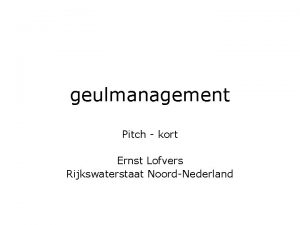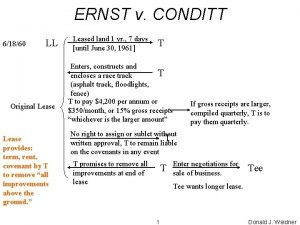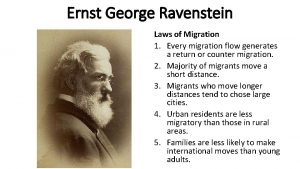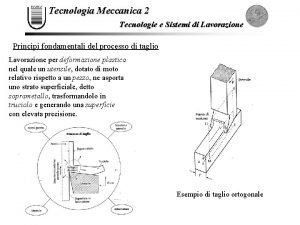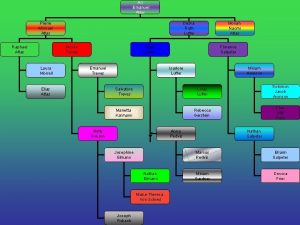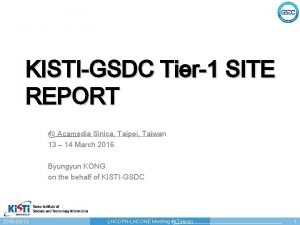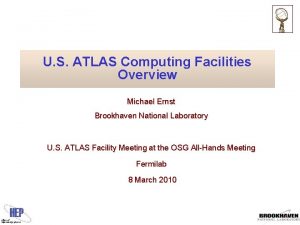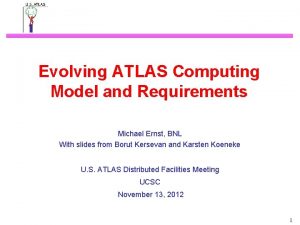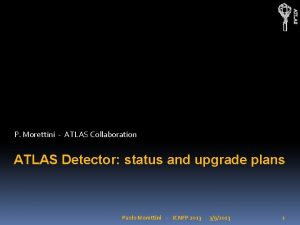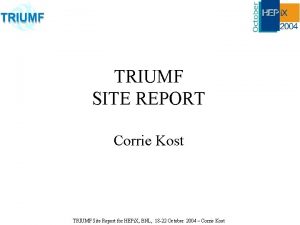U S ATLAS Tier1 Site Report Michael Ernst





































- Slides: 37

U. S. ATLAS Tier-1 Site Report Michael Ernst mernst@bnl. gov U. S. ATLAS Facilities Workshop – March 23, 2015 1

Tier-1 High Value Equipment Deployment Plan • Capacity planning based on Pledges (23% author share) + 20% for US Physicists • FY 15 Equipment Deployment – Equipment (i. e. CPU, disk, central servers) replenished after 4 -5 years of operation 2

Tier-1 Middleware Deployment (1/2) • Below Middleware services are running on VMs • 8 CEs, two of them accept both OSG and ATLAS jobs, the other six are dedicated to ATLAS jobs: – gridgk 01 (BNL_ATLAS_1) is GRAM CE, for all OSG VOs, OSG release 3. 2. 13 – gridgk 02 (BNL_ATLAS_2) is HTCondor CE, for all OSG VOs, OSG release 3. 2. 16 – gridgk 03 (BNL_ATLAS_3) is GRAM CE, OSG release 3. 2. 13 – gridgk 04 (BNL_ATLAS_4) is GRAM CE, OSG release 3. 2. 13 – gridgk 05 (BNL_ATLAS_5) is GRAM CE, OSG release 3. 2. 13 – gridgk 06 (BNL_ATLAS_6) is GRAM CE, OSG release 3. 2. 13 – gridgk 07 (BNL_ATLAS_7) is HTCondor CE, OSG release 3. 2. 18 – gridgk 08 (BNL_ATLAS_8) is GRAM CE, OSG release 3. 2. 19 3

Tier-1 Middleware Deployment (2/2) • we have two GUMS servers gums. racf. bnl. gov, GUMS-1. 3. 18 gumsdev. racf. bnl. gov, GUMS-1. 3. 18 They are configured identical, although one is production and the other is dev. • we have one RSV monitoring host that runs RSV probes against all CEs and the d. Cache SE. services 02. usatlas. bnl. gov, OSG 3. 2. 12 • 3 redundant Condor-G submit hosts for ATLAS APF 4

https: //www. racf. bnl. gov/docs/services/cvmfs/info 5

6

7

Previous, Ongoing and New ATLAS cloud efforts/activities John Hover Previous/Ongoing Some smaller-scale commercial cloud R&D (Amazon, Google) performed at BNL and CERN Currently running at medium scale (1000 jobs) on ~10 academic clouds using University of Victoria Cloud Scheduler. Heavy investment/conversion to Openstack at CERN, majority of Central Services now running on Agile Infrastructure Openstack cluster at Brookhaven National Lab (720 cores) New Collaboration with AWS and ESnet on large-scale exploration of AWS resources for ATLAS Production and Analysis (~30 k concurrent jobs in Nov) Aiming at scaling up to ~100 k concurrent jobs running in 3 AWS regions, 100 G AWS ESnet Network Peerings Use of S 3 Storage AWS-internally and between AWS and ATLAS object Storage Instances


Example us-east-1 region Amazon Web Services Be. St. Man SE Distributed among 3 EC 2 VMs 1 SRM 2 Grid. FTP server S 3 fs (Fuse based file system) 3 buckets mapped into 3 mount points per VM / region: Simple Storage Service (S 3) ATLASUSERDISK ATLASPRODDISK ATLASDATADISK SRM/Grid. FTP protocol data transmission S 3 / HTTP(S) direct access via FTS or APIs S 3/ HTTP(S) via S 3 FS ATLAS PRODUCTON DATA DISTRIBUTION SERVICES

“Impedance mismatch” between commercial and scientific computing

ATLAS Autonomous Multicore Provisioning Dynamic Allocation with Condor William Strecker-Kellogg

ATLAS Tree Structure • Use hierarchical group-quotas in Condor – Leaf-nodes in the hierarchy get jobs submitted to them and correspond 1: 1 with panda-queues – Surplus resources from underutilized queues are automatically allocated to other, busier queues • Quotas determine steady-state allocation when all queues are busy – Quota of parent groups are the sum of their children’s quotas (see next slide for diagram)

ATLAS Tree Structure <root> grid (40) atlas (12000) prod (10000) (quota) analysis (2000) himem (1000) mcore (5500) single (3500) short (1000) long (1000)

Surplus Sharing • Surplus sharing is controlled by boolean accept_surplus flag on each queue – Quotas / surplus are normalized in units of CPUs • Groups with flag can share with their siblings – Parent groups with flag allow surplus to “flow down” the tree from their siblings to their children – Parent groups without accept_surplus flag constrain surplus-sharing to among their children

Surplus Sharing • Scenario: analysis has quota of 2000 and no accept_surplus; short and long have a quota of 1000 each and accept_surplus on – short=1600, long=400…possible – short=1500, long=700…impossible (violates analysis quota)

Partitionable Slots • Each batch node is configured to be partitioned into arbitrary slices of CPUs – Condor terminology: • Partitionable slots are automatically sliced into dynamic slots • Multicore jobs are thus accommodated with no administrative effort – Farm is filled depth first (default is breadth first) to reduce fragmentation • Only minimal (~1 -2%) defragmentation necessary

Where’s the problem? • Everything works perfectly with all single-core • However… Multicore jobs will not be able to compete for surplus resources fairly – Negotiation is greedy, if 7 slots are free, they won’t match an 8 -core job but will match 7 single-core jobs in the same cycle • If any multicore queues compete for surplus with single core queues, the multicore will always lose • A solution outside Condor is needed – Ultimate goal is to maximize farm utilization

Dynamic Allocation • A script watches panda queues for demand – Queues that have few or no pending jobs are considered empty – Short spikes are smoothed out in demand calculation • Script is aware of Condor’s group-structure – Builds tree dynamically from database • This facilitates altering the group hierarchy with no rewriting of the script

Dynamic Allocation • Script figures out which queues are able to accept_surplus – Based on comparing “weight” of queues • Weight defined as size of job in queue (# cores) – Able to cope with any combination of demands – Prevents starvation by allowing surplus into “heaviest” queues first • Avoids both single-core and multicore queues competing for the same resources – Can shift balance between entire sub-trees in hierarchy (e. g. analysis <--> production)

Results

Results • Dips in serial production jobs (magenta) are filled in by multicore jobs (pink) – Some inefficiency remains due to fragmentation • There is some irreducible average wait-time for 8 cores on a single machine to become free • Results look promising, will even allow opportunistic workload to backfill if all ATLAS queues drain – Currently impossible as Condor doesn’t support preemption of dynamic slots… the Condor team is close to providing a solution

OSG Opportunistic Usage at the Tier-1 Center Simone Campana - ATLAS SW&C Week 23 Bo Jayatilaka

OSG Opportunistic Usage at the Tier-1 Center Simone Campana - ATLAS SW&C Week 24

Tier-1 Production Network Connectivity • BNL connected to ESnet at 200 G • Have Tier-1 facility connected to ESnet at 200 G via BNL Science DMZ • • • 30 G OPN production circuit 10 G OPN backup circuit 40 G General IP Services 100 G LHCONE production circuit All circuits can “burst” to the maximum of 200 G, depending on available b/w

BNL WAN Connectivity in 2013 OPN 2. 5 Gbps LHCONE 3. 5 Gbps R&E + Virtual Circuits ATLAS Software and Computing Week - 26

BNL Perimeter and Science DMZ 27

Current Implementation

12 PB WNs

LAN connectivity WN T 1 Disk Storage All WN connected at 1 Gbps Typical bandwidth 10– 20 MB/s, Peak at 50 MB/s Analysis queues configured for Direct read 30

BNL in ATLAS Distributed Data Management (Apr – Dec 2012) Data Transfer activities between BNL and other ATLAS Sites 2 PB 13. 5 PB BNL to ATLAS T 1 s & T 2 s Monthly average transfer rate up to 800 MB/s; daily peaks have been observed 5 times higher MB/s Data Export Data Import BNL in navy blue ATLAS Distributed Data 31 Management Dashboard

CERN/T 1 -> BNL Transfer Performance • Regular ATLAS Production + Test Traffic • Observations (all in the context of ATLAS) – Never exceeded ~50 Gbits/sec – CERN (ATLAS EOS) -> BNL limited at ~1. 5 GB/s • Achieved >60 Gbits/s between 2 Hosts @ CERN and BNL

FTS 3 Service at BNL 33

From BNL to T 1 s 34

35

From T 1 s to BNL 36

From T 1 s and T 2 s to BNL in 2012 - 2013 37
 Michael d. ernst
Michael d. ernst Hot site cold site warm site disaster recovery
Hot site cold site warm site disaster recovery Parasitism
Parasitism Ernst haeckel tree of life
Ernst haeckel tree of life Ernst haeckel ecology
Ernst haeckel ecology Satteldachkonstruktionen
Satteldachkonstruktionen Max ernst forest and dove
Max ernst forest and dove Frottage con monedas
Frottage con monedas Pseudowetenschap beoefend door karl ernst krafft
Pseudowetenschap beoefend door karl ernst krafft Ernst lofvers
Ernst lofvers Enwisen onboarding
Enwisen onboarding Watch wayne cascio videos
Watch wayne cascio videos Van sandt v royster
Van sandt v royster Max ernst horde
Max ernst horde Alison ernst
Alison ernst Ernst jandl markierung einer wende
Ernst jandl markierung einer wende Ernst krieck pädagogik
Ernst krieck pädagogik Ernst schweizer
Ernst schweizer Ernst hotel supply
Ernst hotel supply Ernst deger
Ernst deger Ernst and young moldova
Ernst and young moldova Ernstyoung voice
Ernstyoung voice Ernst haeckel ecology
Ernst haeckel ecology Max ernst fruit d'une longue expérience
Max ernst fruit d'une longue expérience They salute with both hands now analysis
They salute with both hands now analysis Automatisme psychique
Automatisme psychique Ernst ludwig kirchner zelfportret als soldaat
Ernst ludwig kirchner zelfportret als soldaat Ernst and young tax services
Ernst and young tax services Ernst george ravenstein
Ernst george ravenstein Höhlengleichnis skizze
Höhlengleichnis skizze What is it
What is it Ernst ravenstein ap human geography
Ernst ravenstein ap human geography Modello di ernst-merchant
Modello di ernst-merchant Mondrian melo in fiore
Mondrian melo in fiore Ernst schmidheiny
Ernst schmidheiny Ernst haeckel definition of ecology
Ernst haeckel definition of ecology Max ernst le rossignol chinois
Max ernst le rossignol chinois Ernst schmidheiny
Ernst schmidheiny









